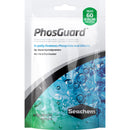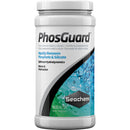





PhosGuard™ rapidly removes phosphate and silicate from marine and freshwater aquaria. Although PhosGuard™ is effective in both fresh and marine water, it will operate better in sea water and the need for it is better defined in sea water. It is not recommended for phosphate buffered freshwater (PhosGuard™ would remove the buffer until saturated). PhosGuard™ is highly porous and bead-shaped to promote easy water flow through and around it, thereby increasing both its efficiency and capacity.
Sizes: 100 mL, 250 mL, 500 mL, 1 L, 2 L, 4 L
Directions
May generate heat on initial contact with water. Pre-wet by adding to a double volume of freshwater, followed by a rinse. For best results, PhosGuard™ should be rinsed before use and placed so as to maximize the flow of water through it but not so that it tumbles against itself in flow. It may be used in a canister filter, media chamber, box filter, or any high flow area of a trickle filter. Use of a filter bag is recommended. Use 85 mL (1/3 cup) for every 200 L (50 US gallons) saltwater or 400 L (100 US gallons) freshwater.
Leave product in place for 4 days, then test phosphate or silicate concentrations with either MultiTest™ Phosphate or MultiTest™ Silicate. If the concentration of the component you are trying to decrease has not dropped to around 0.02 mg/L, then replace the PhosGuard™, otherwise leave in place until levels begin to climb again. As long as concentrations remain under control, the product is not exhausted. Over treating is not recommended. PhosGuard™ is not an exchange resin and does not release anything into the water. It does not leach phosphate or silicate back into the water and may be removed, dried, and returned to service until exhausted. Continuous use of small quantities is better than intermittent use of larger quantities.
FAQ
How do I use PhosGuard™? How long does it work and when is it exhausted?
A: PhosGuard™ is best used in smaller quantities and changed frequently. In an environment with an excessively high phosphate reading, PhosGuard™ will exhaust rapidly (4 – 5 days). Place the product in a high flow rate area and test your phosphate levels, changing as needed. When you see that your level is below 0.2 ppm (mg/L) leave that portion of PhosGuard™ in the filter. PhosGuard™ may yellow somewhat as it picks up organics, but that is not an indicator of exhaustion for phosphate removal. Continue to test weekly for phosphate until you see it begin to rise again. You will then know that it is time to change the PhosGuard™. If you have low levels of phosphate the PhosGuard™ will absorb the silicate in your system. It’s inert and safe to leave in your filter.
Is PhosGuard™ regenerable?
A: Although some manufacturer’s claim that their aluminum oxide based phosphate removing products can be regenerated by intense heat, this is, unfortunately, not the case. That claim is based on a naive interpretation of the information provided by manufacturers of bulk aluminum oxide. Aluminum oxide is more commonly used in gas purification to remove volatile organics and moisture; heating the material after such use will release the non-covalently adsorbed compounds. However, heat cannot result in phosphate release from aluminum oxide due to a difference in the nature by which phosphates are bound to aluminum oxide versus adsorbed gases.
I was told that products that contain aluminum oxide will release aluminum, which will close corals for weeks and might even damage them. Is this accurate?
A: In recent years, there has been speculation that aluminum oxide based phosphate removers like PhosGuard™ release aluminum into the water and subsequently damage corals. The evidence to support this claim was largely anecdotal.
So, through a series of controlled experiments in both freshwater and saltwater, we intended to address both the question of aluminum solubility and aluminum toxicity. The results of these experiments show that under reef conditions (pH near 8) there is no detectable soluble aluminum released from alumina. Under conditions of low pH and high dosage levels, soluble aluminum can be released from alumina; at three times the label dosage rate, we detected 0.2 mg/L aluminum at a pH of 5.3.
Additionally, aluminum oxide is not easily absorbed into the cell to cause negative reactions. Even at three times the dose of PhosGuard™, soft-bodied corals such as Sarcophyton remain unaffected.
If PhosGuard™ doesn’t release aluminum that will stress corals, then why did my corals close a day after I added PhosGuard™?
A: Phosphate plays a major role in the chemistry of the aquarium, and an overdose of PhosGuard™ is capable of very rapidly lowering the phosphate concentration in the aquarium. If an overdose of PhosGuard™ is used, it is possibly to lower the phosphate concentration so quickly that corals become stressed.
Company X says that I don’t need to replace their phosphate absorber for several months, while your instructions say that PhosGuard™ needs to be replaced every 4 days when reducing phosphate. Doesn’t that make PhosGuard™ an inferior product?
A: Not at all! If it takes a phosphate absorber several months to reach its full capacity when the tank has high phosphates, it means that the media is exceptionally slow at absorbing phosphate. PhosGuard™ needs to be replaced every 4 days as long as there is a phosphate problem because, given an infinite amount of available phosphate, PhosGuard™ absorbs phosphate so quickly that it reaches its full capacity in 4 days. The 4 day replacement period is a function of how quickly the media works, not a function of how high a capacity the media has.
Can I use PhosGuard™ in a media reactor?
A: We do not recommend it, as the tumbling action of a media reactor can cause this media to produce dust.
Sizes: 100 mL, 250 mL, 500 mL, 1 L, 2 L, 4 L
Directions
May generate heat on initial contact with water. Pre-wet by adding to a double volume of freshwater, followed by a rinse. For best results, PhosGuard™ should be rinsed before use and placed so as to maximize the flow of water through it but not so that it tumbles against itself in flow. It may be used in a canister filter, media chamber, box filter, or any high flow area of a trickle filter. Use of a filter bag is recommended. Use 85 mL (1/3 cup) for every 200 L (50 US gallons) saltwater or 400 L (100 US gallons) freshwater.
Leave product in place for 4 days, then test phosphate or silicate concentrations with either MultiTest™ Phosphate or MultiTest™ Silicate. If the concentration of the component you are trying to decrease has not dropped to around 0.02 mg/L, then replace the PhosGuard™, otherwise leave in place until levels begin to climb again. As long as concentrations remain under control, the product is not exhausted. Over treating is not recommended. PhosGuard™ is not an exchange resin and does not release anything into the water. It does not leach phosphate or silicate back into the water and may be removed, dried, and returned to service until exhausted. Continuous use of small quantities is better than intermittent use of larger quantities.
FAQ
How do I use PhosGuard™? How long does it work and when is it exhausted?
A: PhosGuard™ is best used in smaller quantities and changed frequently. In an environment with an excessively high phosphate reading, PhosGuard™ will exhaust rapidly (4 – 5 days). Place the product in a high flow rate area and test your phosphate levels, changing as needed. When you see that your level is below 0.2 ppm (mg/L) leave that portion of PhosGuard™ in the filter. PhosGuard™ may yellow somewhat as it picks up organics, but that is not an indicator of exhaustion for phosphate removal. Continue to test weekly for phosphate until you see it begin to rise again. You will then know that it is time to change the PhosGuard™. If you have low levels of phosphate the PhosGuard™ will absorb the silicate in your system. It’s inert and safe to leave in your filter.
Is PhosGuard™ regenerable?
A: Although some manufacturer’s claim that their aluminum oxide based phosphate removing products can be regenerated by intense heat, this is, unfortunately, not the case. That claim is based on a naive interpretation of the information provided by manufacturers of bulk aluminum oxide. Aluminum oxide is more commonly used in gas purification to remove volatile organics and moisture; heating the material after such use will release the non-covalently adsorbed compounds. However, heat cannot result in phosphate release from aluminum oxide due to a difference in the nature by which phosphates are bound to aluminum oxide versus adsorbed gases.
I was told that products that contain aluminum oxide will release aluminum, which will close corals for weeks and might even damage them. Is this accurate?
A: In recent years, there has been speculation that aluminum oxide based phosphate removers like PhosGuard™ release aluminum into the water and subsequently damage corals. The evidence to support this claim was largely anecdotal.
So, through a series of controlled experiments in both freshwater and saltwater, we intended to address both the question of aluminum solubility and aluminum toxicity. The results of these experiments show that under reef conditions (pH near 8) there is no detectable soluble aluminum released from alumina. Under conditions of low pH and high dosage levels, soluble aluminum can be released from alumina; at three times the label dosage rate, we detected 0.2 mg/L aluminum at a pH of 5.3.
Additionally, aluminum oxide is not easily absorbed into the cell to cause negative reactions. Even at three times the dose of PhosGuard™, soft-bodied corals such as Sarcophyton remain unaffected.
If PhosGuard™ doesn’t release aluminum that will stress corals, then why did my corals close a day after I added PhosGuard™?
A: Phosphate plays a major role in the chemistry of the aquarium, and an overdose of PhosGuard™ is capable of very rapidly lowering the phosphate concentration in the aquarium. If an overdose of PhosGuard™ is used, it is possibly to lower the phosphate concentration so quickly that corals become stressed.
Company X says that I don’t need to replace their phosphate absorber for several months, while your instructions say that PhosGuard™ needs to be replaced every 4 days when reducing phosphate. Doesn’t that make PhosGuard™ an inferior product?
A: Not at all! If it takes a phosphate absorber several months to reach its full capacity when the tank has high phosphates, it means that the media is exceptionally slow at absorbing phosphate. PhosGuard™ needs to be replaced every 4 days as long as there is a phosphate problem because, given an infinite amount of available phosphate, PhosGuard™ absorbs phosphate so quickly that it reaches its full capacity in 4 days. The 4 day replacement period is a function of how quickly the media works, not a function of how high a capacity the media has.
Can I use PhosGuard™ in a media reactor?
A: We do not recommend it, as the tumbling action of a media reactor can cause this media to produce dust.
Payment & Security
Your payment information is processed securely. We do not store credit card details nor have access to your credit card information.

